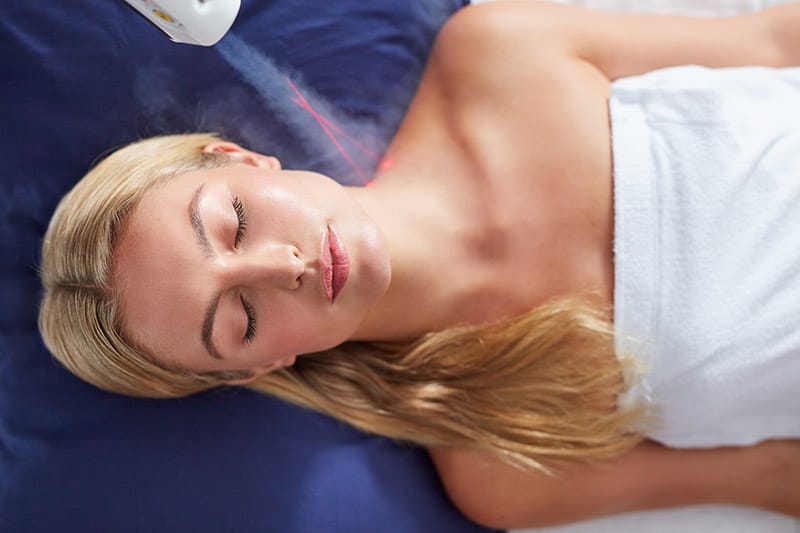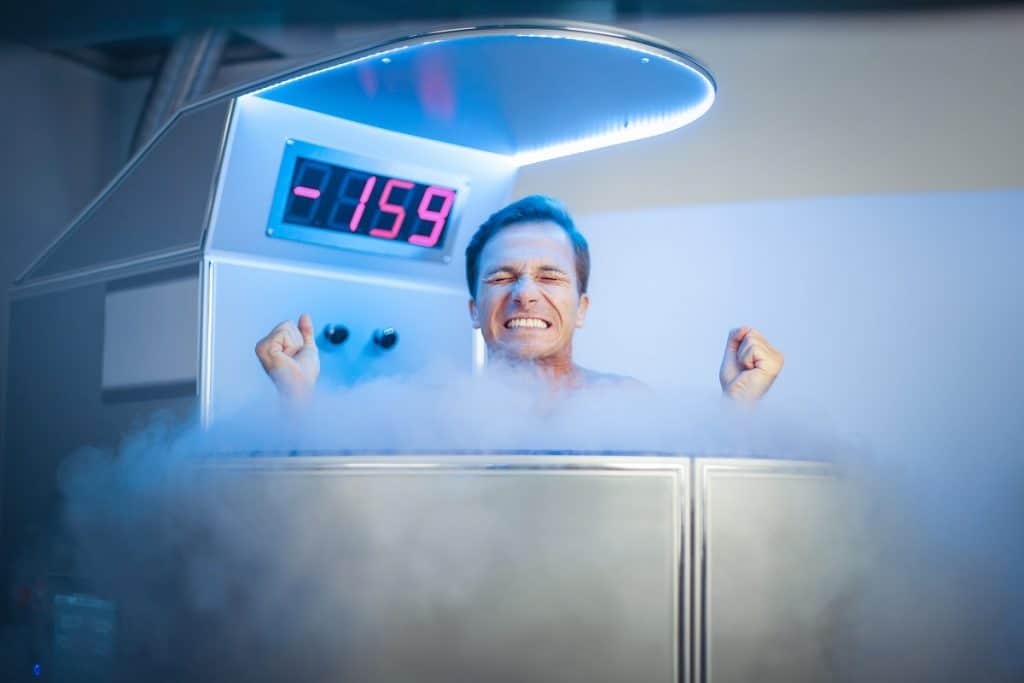Since before recorded history, humans have been turning to temperature therapy (both hot and cold) to optimize health, purify the body, and to find commune with a higher power. From the Finnish tradition of rolling around in the snow followed by traditional sauna sessions, to the Haman’s of the Ottoman empire, where individuals plunged themselves into ice-cold water followed by the steam room, humans are no strangers to treating ailments with extreme temperatures.
The marriage of thermal therapy continues to evolve today as technology is developed to create state-of-the-art treatments. Broad spectrum Infrared sauna therapy coupled with cryotherapy is the crowning achievement of ancient wisdom unified with modern technology to foster health and wellness through thermal therapy.
What is Cryotherapy?
Cryotherapy treatment is a supercharged ice bath that enhances an individual’s natural healing capabilities by subjecting the body to extreme cold. Cryotherapy is the coolest new thing on the health and wellness market, and while it boasts scientific backing, it is not yet FDA certified.
If you are looking to enhance your infrared sauna therapy with a blast of cold, there is evidence to suggest that cryotherapy is an excellent compliment to infrared sauna treatments. Use of infrared saunas regularly may produce a greater degree of health benefits thus positively affecting very serious conditions compared to its colder counter Cryotherapy.
This article will help you to understand the physiological response to both modalities of thermal therapy and how when used in tandem to how they cooperatively work to optimize your health.
Cold Immersion For Healing Purposes

Cryotherapy is on the cutting edge of wellness treatments available today. Although the technology itself is new, immersion of the body into deliberately cold water is an ancient practice. Athletes looking to speed recovery time between workouts often use ice baths to encourage muscular repair. Yogis have been using ice-cold showers to stimulate and improve the immune response for hundreds of years, and the cultural tradition of Russians plunging themselves into cold bodies of water is world famous.
So why have so many people throughout history turned to therapies that involve submersion of the entire body into frigid waters?
It is believed that entering ice baths or very cold bodies of water constricts blood vessels to flush waste products, such as lactic acid out of the muscle tissue, decreasing metabolic activity to reduce swelling and tissue breakdown. Micro-tears occur to the muscles during exercise (this is how muscles develop) and by exposing these same muscle groups to the cold, healing occurs at faster rates allowing the individual to return to workouts sooner (1).
Ice packs applied to torn ligaments and tendons also speeds up recovery by improving circulation of healthy, nourishing blood to the injured region to decrease inflammation. Cryotherapy works with the same premise of ice compresses and cold-water immersion and then takes it several steps further with state-of-the-art technology to enhance the experience.
Toshima Yamauchi, a Japanese medical professional looking to find relief for patients suffering from rheumatoid arthritis, developed the first cryotherapy instruments. Originally, freezing instruments were applied to specific inflamed regions of the body to encourage improved circulation and reduce painful symptoms. The technology has evolved to encompass the entire body, referred to as a cryochamber or cryosauna (2).
Most cryotherapy clinics today offer a vertical metal tube (cryochamber) that individuals walk into with their heads exposed. Temperatures plummet to anywhere from negative 112 degrees Fahrenheit to negative 256 degrees Fahrenheit. Each session lasts for only 3 minutes and individuals in the cryotherapy machine are monitored by a health care chaperone.
The extreme temperatures of whole body cryotherapy are created with liquid nitrogen. The upright metal container that encompasses the individual appears to be filled with dry ice and has a foggy look and feel.
One could consider cryotherapy as a supercharged ice bath.
Cryotherapy maximizes the benefits of cold therapy by essentially freezing the outermost layers of the body. Due to the extreme cold, blood flows inward toward the vital organs to protect them. Ultimately, this feeds the essential organs with a surplus of healthy, nutrient-filled blood (1).
The Physiological Response To Cryotherapy
The body is startled by the extreme cold and elicits a strong sympathetic (fight or flight) response from the autonomic nervous system. Like an elastic band, this response ricochets back as a dramatic parasympathetic (rest and relaxation) rebound of the autonomic nervous system. Two to three minutes is all that is needed to unleash a cascade of biochemical reactions that emphatically improves circulation, neuromuscular transmission, and immune response (3).
The circulatory system is stimulated and rapidly draws blood away from the outer extremities of the body into the vital organs as a means of protection. Once the individual is relieved of the cold environment and steps out of the cryochamber, blood pours quickly back to the peripheral tissues of the body. After intense intermingling with the vital organs, blood is renewed. As blood flows outward to the peripheral regions of the body, it provides richly oxygenated hemoglobin to the joints and skin. This activity greatly reduces inflammation, and therefore painful symptoms.
Positive immune responses include increased white blood cell counts, increased anti-inflammatory cytokines, and reduced pro-inflammatory prostaglandin PGE2. By creating an artificial shock to the system, a multitude of physiological responses occur and the results on the health of the body are remarkable (3).
What To Expect During Your First Cryotherapy Session

You will not need to set much time aside during your day, as you will likely be in and out of the cryotherapy clinic in less than 10 minutes. You will be invited back to a room that holds the cryochamber and left alone to disrobe. You will be instructed to put mittens on your hands as well as socks and wetsuit booties on your feet. Men will be given thermo-underwear or some garment to protect their genitals from the cold. It is also advisable to cover the nipples as the extreme cold can be very uncomfortable. Women should consider wearing a bra for this purpose.
You will step into the chamber that will have already been adjusted for your height so that your neck and head remain outside of the enclosure. Once inside the cryotherapy chamber, an attendant will enter the room to monitor the session. While cryotherapy is considered safe, the chaperone will be present for additional safety precautions.
The session will last only three minutes. When the time is up the chaperone will leave the room, you will step out of the chamber and put your clothes back on. Most likely you will experience a spike in energy and may feel a slight ‘high’. Be sure to have the heat on in your car or a warm jacket, as you will feel cold for several hours afterward. As a lot of energy is burned, you will most likely find yourself unusually hungry after each session.
You can expect to pay somewhere between $25-$35 per session. You cannot have a cryotherapy apparatus in your own home and all sessions must be administered by a cryotherapy professional.
Infrared Sauna Therapy Boasts More Health Benefits
When it comes to using an infrared sauna versus cryotherapy, Infrared sauna therapy uses penetrative light to heat the body up from the inside out and can be considered the inverse of cryotherapy. Both therapies provide resounding health benefits and ideally, cryotherapy could compliment regular infrared sauna therapy treatments.
Both modalities improve circulation, reduce inflammation, aid in muscular recovery, and are great for weight loss. Infrared sauna therapy has exponentially more health benefits that may directly aid and assist in finding remission for chronic conditions and relief from painful symptoms.
The relationship between the molecular and cellular make-up of the body and the infrared light spectrum is unparalleled by any other healing modality. Infrared sauna therapy powerfully detoxifies the body through copious sweating. This reduces internal stress from toxic overload, improves oxygenation of the blood, and encourages positive circulation that bolsters a myriad of results on overall health by reducing inflammation.
Infrared sauna therapy also stimulates neurogenesis (the creation of new brain cells) (4), increases human growth hormones (5), and heightens insulin sensitivity (6). These physiological responses mean that individuals with type II diabetes, brain degenerative diseases, such as Alzheimer’s and Parkinson’s disease, and autoimmune conditions will benefit from infrared sauna therapy in life-altering ways (4).
Additionally, the infrared sauna does not enlist sympathetic (fight or flight) dominance of the autonomic nervous system as cryotherapy does but rather, immediately coaxes the body back into states of parasympathetic (recovery, rest, healing, nourishment, and relaxation) dominance.
Underlying correlative factors of chronic conditions is believed to be prolonged states of stress response. Infrared sauna therapy will draw individuals into states of relaxation where nourishment and healing can occur. Regular infrared sauna therapy will encourage parasympathetic dominance throughout the day and therefore reduce stress response to encourage optimal health (7).
The cascade of health benefits for individuals engaged in regular infrared sauna therapy are far more numerous and profound than those found through cryotherapy.
Nevertheless, cryotherapy is an excellent compliment to infrared sauna therapy. If you are using infrared saunas 4-7 times per week then you may want to consider cryotherapy once a week. The extreme cold will boost blood circulation and improve immune response.
Consider cryotherapy as the cherry on top of your health and wellness routine, while infrared sauna is the basic nourishment that could change the future of your health.
Infrared Sauna Therapy vs. Cryotherapy: Infrared Sauna Therapy Is More Enjoyable, Cost-Effective, and Convenient

The warm, radiant hues of infrared light soothe the soul and heal the body. The experience of an infrared sauna is deeply relaxing and may positively alter states of being. Cradled within the warmth of an infrared sauna is a luxurious and deeply pleasurable experience.
Conversely, cryotherapy is not relaxing and is a therapy that must be endured as you rally courage to endure the uncomfortably extreme cold. You may find yourself jumping up and down in the chamber waiting anxiously for the time to be up so you can feel comfortable again. As you luxuriate in your infrared sauna you may not want to leave even after 50 minutes, so comfortable and relaxed will you be.
Infrared sauna therapy is an introspective period of time where you can melt into your inner world. Not so with cryotherapy, an attendant will be in the room with you as you jump around and look for ways to endure the uncomfortable plummeting temperatures.
For a small investment, you can safely bring an infrared sauna into your home. Cryotherapy is still not FDA approved, the whole body chambers are not available for public purchase.
If you are lifting heavy weights, training for a marathon, or engaged in any other extreme exercise regime, then cryotherapy could be a great substitute for your ice bath. Cryotherapy treatment could be an excellent weekly or bi-weekly compliment to your regular infrared sauna routine.
If you have any more questions about infrared sauna therapy versus cryotherapy, please contact us at Saunas.org today!
Sources:
- https://www.ncbi.nlm.nih.gov/pmc/articles/PMC3766664/
- https://globalsportmatters.com/tag/dr-toshima-yamauchi/
- https://www.ncbi.nlm.nih.gov/pubmed/18785356
- https://www.ncbi.nlm.nih.gov/pmc/articles/PMC5066074/
- https://master-athlete.com/coaching/sitting-in-a-sauna-can-raise-human-growth-hormone-hgh/
- https://www.researchgate.net/publication/326203347_Effect_of_Steam_Sauna_Bath_on_Fasting_Blood_Glucose_Level_in_Healthy_Adults
- https://www.ncbi.nlm.nih.gov/pubmed/23859414
Additional Reading Material:
- http://www.chirosportsusa.com/index.php?p=493064
- https://www.alphaluxe.com/2016/08/cryotherapy-vs-infrared-saunas-which-is-right-for-you/
- https://www.inc.com/cameron-albert-deitch/whole-body-cryotherapy-is-taking-over-america.html
- https://en.wikipedia.org/wiki/Turkish_bath
https://www.inc.com/cameron-albert-deitch/whole-body-cryotherapy-is-taking-over-america.html


